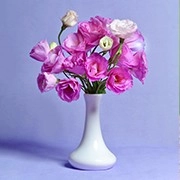Eggplant Charm

Lykkers, have you ever paused in the produce aisle and noticed that deep purple vegetable quietly sitting there? That’s eggplant, a humble yet fascinating star in the vegetable world.
From its shiny, dark skin to its soft, flavorful flesh, eggplant tells a story that spans continents and centuries. Today, we’ll explore how this vegetable has captured our taste buds and kitchen hearts worldwide, and why it deserves a special spot on our plates.
Origins and Varieties
Eggplant has a long and adventurous history. It first appeared in tropical Asia and gradually spread across the globe through trade and migration. Today, it’s grown almost everywhere, offering countless varieties and shapes. From long, slender types to round “bulb” forms, and colors ranging from deep purple to green and even white, each eggplant has its own taste and story.
Among them, the classic purple eggplant is the most recognized. Its rich purple skin gleams under sunlight, almost like nature’s own artwork, inviting us to take it home and cook. Some varieties are smaller and tender, perfect for quick roasting or frying, while others are larger with dense flesh, ideal for stuffing or slow-baking. Knowing which type to pick can make all the difference in your kitchen adventures.
Nutritional Value and Health Benefits
Beyond its looks, eggplant packs a nutritional punch. It’s rich in dietary fiber, vitamin P, potassium, and trace minerals. These nutrients help support digestion, maintain healthy blood pressure, and promote overall heart and circulatory wellness. Vitamin P, in particular, strengthens blood vessels and helps protect them from damage.
Eggplant also contains antioxidants, including polyphenols and flavonoids, which combat free radicals, slow the aging process, and protect cells from harm. The spongy texture of eggplant helps it absorb healthy oils and spices, allowing us to enjoy rich flavors without excessive salt or sugar. In short, eggplant is a quiet health hero on our plates that nourishes both body and taste buds.

Cooking Art and Flavor Exploration
Eggplant is incredibly versatile in the kitchen. Around the world, it shines in a variety of dishes. Across South Asia, it stars in flavorful curries like Baingan Bharta, mashed and spiced with garlic and tomatoes. In the Mediterranean, roasted eggplant becomes smoky and tender, often paired with olive oil, herbs, and tahini. In Japan, eggplant is used in tempura, miso-glazed dishes, and savory stir-fries.
Grilling, baking, roasting, or sautéing eggplant all bring out different textures and flavors. You can even stuff it with grains, vegetables, or cheese for a hearty, plant-based meal. Its ability to absorb seasonings and oils makes it a perfect partner for bold flavors—from tangy lemon to earthy cumin. For Lykkers who enjoy experimenting, trying a new spice blend with eggplant can transform a simple vegetable into a gourmet treat.
Cultural Significance
Eggplant carries meaning beyond taste. In some cultures, it’s a symbol of luck, abundance, and prosperity. Its rounded, full shape often represents completeness and happiness. The deep purple color adds an air of mystery and elegance, inspiring art, literature, and design.
Historically, eggplant appeared in artwork, home gardens, and even storytelling, reflecting its value as both food and inspiration. Some regions associate it with cleverness and creativity because its texture and versatility require skillful cooking to bring out its best. Across the globe, eggplant is celebrated in festivals, markets, and family traditions—an everyday vegetable with extraordinary presence.
Tips for Selecting and Storing
When picking eggplant, look for smooth, glossy skin and firm flesh. Avoid blemishes or wrinkled areas. Smaller eggplants usually have a sweeter, less bitter taste, while larger ones are ideal for hearty dishes. Store them in a cool, dry place and use them within a few days for the best flavor. Cutting and sprinkling a little salt on raw slices can reduce bitterness and improve texture, a simple trick many home cooks swear by.
Eggplant’s Purple Legacy
So next time we see an eggplant, let’s remember it’s more than just a purple vegetable. It’s a source of nourishment, a canvas for cooking creativity, and a symbol of life’s abundance. By exploring its flavors, textures, and stories, we continue a tradition that connects fields to tables across the world.
Lykkers, whether roasted, grilled, or curried, eggplant reminds us that simple ingredients can create extraordinary experiences. Here’s to celebrating eggplant in all its glory and letting this purple legend shine brightly in our meals!
The Eggplant: A Journey from Origin to Your Plate
Video by Natures_Hub

 · Cate team
· Cate team